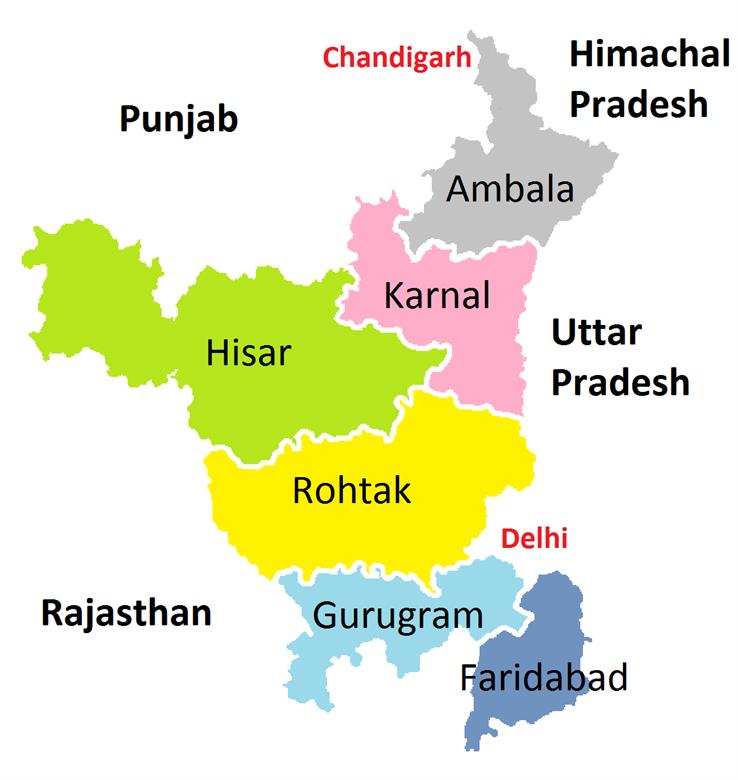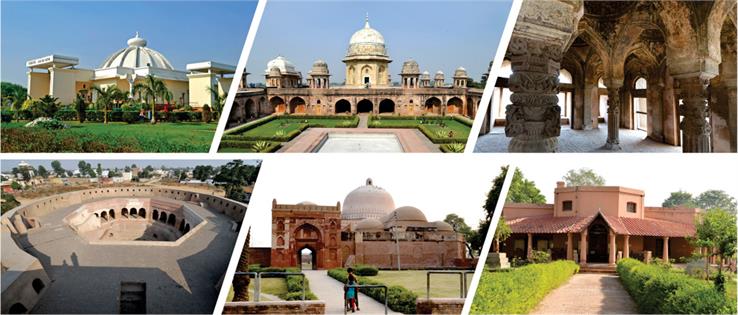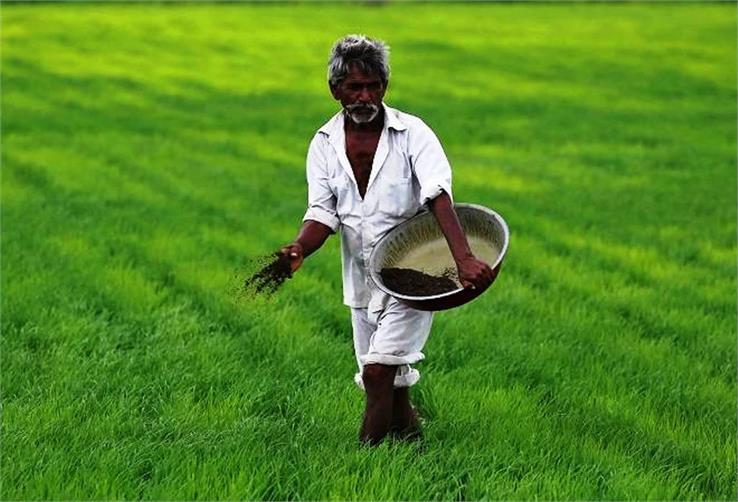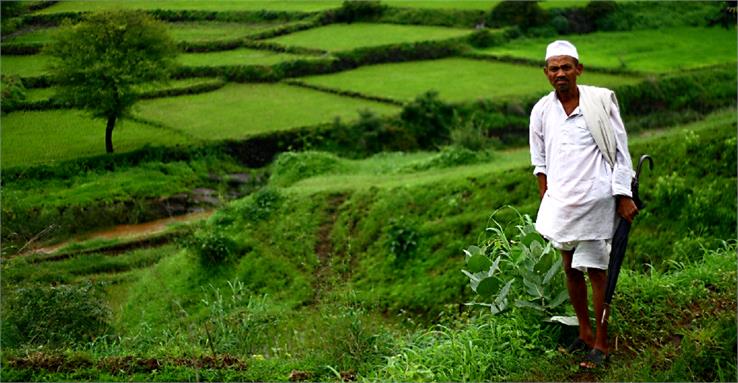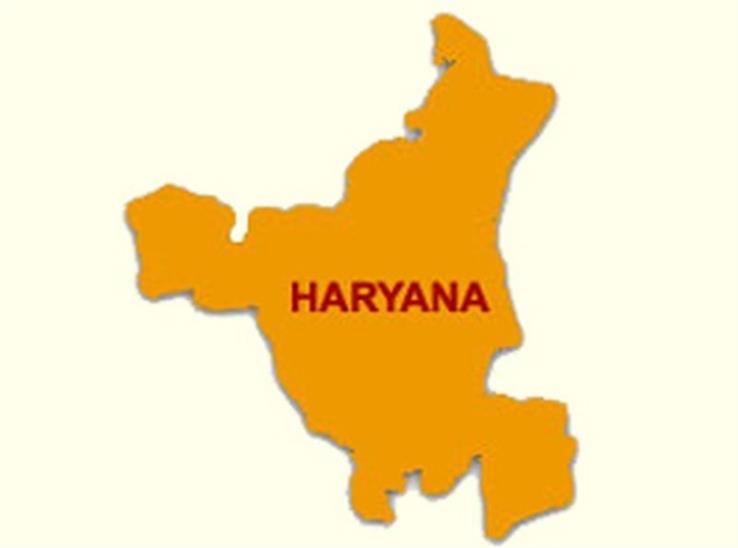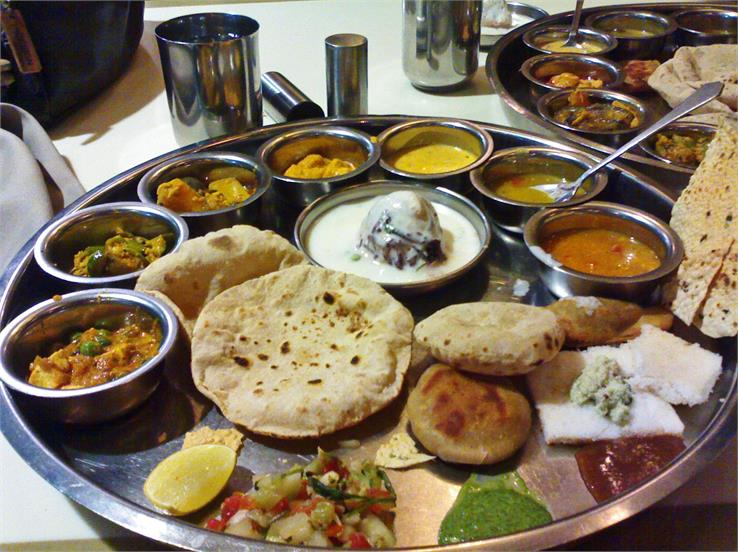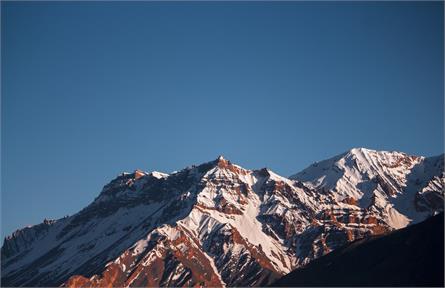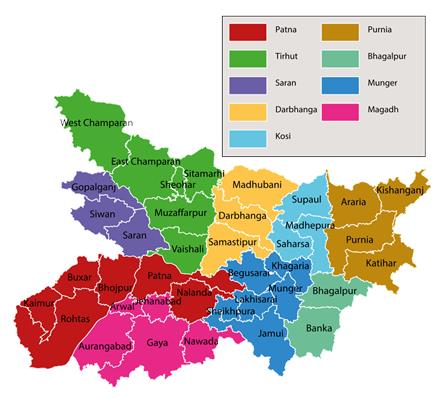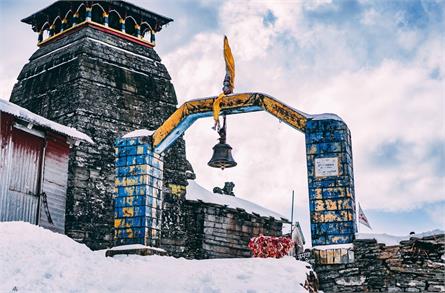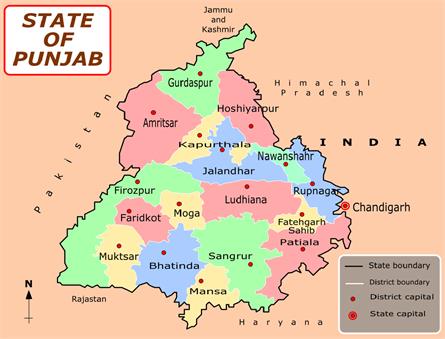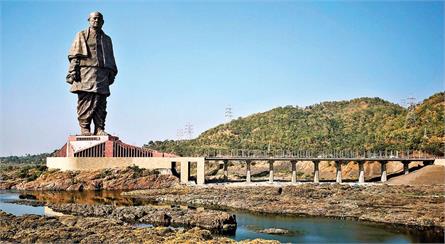Haryana - Green Land of India
The green land of India, Haryana is a hub of culture, tradition, and rich heritage and a kingdom of amiable people. The state is not only known for its tourism and historical sites but also famous for its pleasant climate and bizarre landscape. Haryana is a cultural part of India where modern buildings, lush green fields, and a rich culture makes it a special place. The state also hosts many species of birds, both residential and migratory. There are many temples and lakes here which are unquestionably worth-seeing.
Haryana was formed in 1966 by dividing the Punjab province of North India. The boundaries of Haryana are adjoining on three sides of Delhi, the capital of India. Due to which a considerable part of the National Capital Territory of Delhi is merged with Haryana. The capital of Haryana is Chandigarh.
The meaning of the word 'Haryana' is 'habitation of God,' where 'hari' means Vishnu, and 'ayan' denotes home. The area of Haryana is spread over 44,212 sq. km, including the largest city Faridabad.
History
The region of Haryana (Central region of the post-Vedic era, around 800-500 BC) is considered as the birthplace of Hinduism. It is in the region where the first chants of the Aryans were sung, and various ancient scripts were addressed. In an inscription dated 1327, 'Dhillika' or 'Delhi' is mentioned under Haryana.
As per the opinion of scholars, the word 'Haryana' is a distortion of 'Ahirana.' Due to the good grazing land in the region since ancient times, there has been a residence of Ahirs or Abhiras. The ancient history of Haryana is awe-inspiring, which begins from the Vedic period. This state is considered to be the birthplace of the legendary 'Bharata dynasty,' after which this country was named 'Bharat.' Haryana is mentioned in the epic Mahabharata. Kurukshetra, the battleground of Kauravas and Pandavas, is in Haryana. Haryana has played an essential role in the history of India until the arrival of Muslims and before Delhi became the capital of India. Later, Haryana became a part of Delhi and was not getting enough importance until the first freedom struggle in 1857.
Historical Battleground
Haryana is known as a historical battleground. Under the guise of infiltration from the Northwest and Central Asian regions, Haryana had suffered numerous army invasions from the time of Alexander the Great (326 BCE). It has witnessed many decisive battles in Indian history, chief among them are -
- Battles of Panipat - In 1526, when the Mughal emperor Babur defeated Ibrahim Lodi and laid the foundation of the Mughal Empire in India.
- In 1556, the Afghan army was defeated by the Mughal emperor Akbar's army.
- Battle of Karnal in 1739 - The Nadirshah of Persia overpowered the collapsing Mughal Empire.
- In 1761, when Ahmad Shah Abdali decisively defeated the Maratha army, it cleared the way for British rule in India.
Haryana as a State

Haryana foundation day is celebrated on 1 November every year as the state of Haryana was established on 1 November 1966. On the re-establishment of British rule after suppressing the revolt of 1857, the British either merged in their own territories of the Nawabs of Jhajjar and Bahadurgarh, Raja of Ballabgarh and Rao Tularam of Rewari, or handed over to the rulers of Patiala, Nabha and Jind. And thus, Haryana became a part of Punjab province. After the reorganization of Punjab province on 1 November 1966, Haryana attained full statehood.
The area under the present Haryana state was handed over to the British East India Company in 1803. In 1832, it was transferred to the Northwestern Province, and in 1858 the region became part of Punjab. It remained in the same position until the partition of India in 1947, although the demand for a separate Haryana state had already begun to arise in 1907 before India's independence. Lala Lajpat Rai and Asaf Ali, the prominent leaders of the 'Indian National Movement,' supported the separate state of Haryana. Despite being a part of Punjab before and after independence, it was recognized as a distinct cultural and linguistic unit, although it was a socio-economically backward region. The “Haryana Development Committee,” chaired by veteran freedom warrior Shri Ram Sharma, focused on the concept of an autonomous state. Due to the Punjab Reorganization Act in 1966, Haryana also became a separate state of India.
Geography
Haryana is located in the northern part of India and has a geographical location of 30.73 degrees north and 76.78 degrees east. Some part of this state comes in the National Capital Region. The state of Haryana is bounded by Himachal Pradesh and Punjab on the northern side, Uttar Pradesh on the eastern side, Uttarakhand and Rajasthan on the west side.
Haryana has two large landmasses, a large part of the state is covered with flat alluvial plains, and in the northeast, there are sharp Shivalik hills and narrow mountainous areas. The only perennial river Yamuna moving from the plains of 210 m to 270 m high sea level, flows through the eastern border of the state. Several seasonal rivers originating from the Shivalik hills pass through the plains and Ghaggar (near the northern border of the state) is the most prominent river amongst them. In the lower region of this river, the remains of Pre-Aryan civilization were found. Apart from this, the remnants of the extensive Aravalli mountain range from south to north of Delhi are also found in Mahendergarh, Rewari and Gurugram districts of South Haryana.
Most of the region of Haryana are in arid and semi-arid conditions. Only a little humidity is found in the east. Haryana has canal irrigation systems and large tube wells. Despite this, there are some highly drought-prone areas, especially in the southern and south-western parts. However, there are random floods in the tributaries of the Yamuna and Ghaggar rivers. In summer (May-June), the maximum temperature reaches 46 degrees. The minimum temperature sometimes reaches the deposition point in January.

The soil is deep and fertile throughout the state except for the hilly foothills in the northeast, and the land is sandy in the border region adjoining the Rajasthan desert in the southwest. Farming takes place on fourth-fifth of the total area of the state, and about three-fourth is irrigated. Irrigation is done through tube wells in the northern, eastern, and southeastern parts of the state, while most of the irrigation in the south-western region is through canals. The state has a negligible forest area. Eucalyptus trees have grown on the side of highways and roadways. Indian rosewood (Dalbergia sissoo or Sheesham) trees are commonly found on the roadside in the northern parts of the state, while Gum arabic trees (Acacia arabica or kikar) and shrubs are often found in south and south-western Haryana.
Major Cities of Haryana
- Faridabad
- Gurugram
- Panipat
- Ambala
- Karnal
- Yamunanagar
- Rohtak
- Hisar
- Sonipat
- Panchkula
- Kurukshetra
- Jhajjar
- Bhiwani
- Rewari
- Palwal
- Sirsa
- Jind
- Bahadurgarh
- Narnaul
- Chandigarh
Demography
According to the 2011 census, Haryana has a total population of 25,353,081, and its population density is 573.4 sq km. The sex ratio of the state Haryana is 877 females per 1000 males, and Hindus abound in the population here. People from other religions and faiths also reside in the state, such as Christians, Sikhs, Muslims, and Jains. Apart from this, people from other communities like Dalits and Valmiki are also part of the population here.
Economy and Infrastructure
Agriculture

Haryana is a prosperous state in terms of agriculture, and it provides large quantities of wheat and rice to the central repository (National Storage System of Additional Food grains). Agriculture is the basis of livelihood for more than 65 percent of people in Haryana. Agriculture contributes around 26.4 percent of the state's domestic production. The production capacity of food grains was 25.92 lakh tonnes at the time of state formation. Presently, gross agricultural production has increased at a larger rate with the increase in the production of major crops.
Haryana is a major producer of wheat and rice. Cotton, sugarcane, pulses, millet, oilseeds, potatoes, and sorghum are other primary crops of the state. The state is the largest exporter of basmati rice in the world's market. Sunflower, soybeans, peanuts, horticulture are also being encouraged. The production of Sesbania bispinosa (Dhaincha) and Mung bean (Moong) are also being produced to improve soil fertility.
Irrigation
For the equitable distribution of irrigation and drinking water in the state, the government has constructed a 109 km long canal 'Bhakra Main Canal - Hansi Branch - Butana Branch Multipurpose Contact Canal.' Dadupur-Nalvi Canal Project has been started to utilize the additional water of the Yamuna river in monsoon. Under this project, 590 cusecs of additional water will be used for irrigation and groundwater recharge facilities (92,532 hectares of land) in Yamuna Nagar, Ambala, and Kurukshetra. The work is under process on Ghaggar and its tributaries on four low-altitude dams - Kaushalya Dam, Dangrana Dam, Diwanwala Dam, and Chhamla Dam, which will increase the use of monsoon water.
Industry
The industrial area of Haryana is extensive and vast. There are 1,343 large and 80,000 small scale industrial units in the state. Many products are manufactured in the state. Haryana is the biggest producer of several kinds of tractors, bikes, refrigerators, cars, scientific tools, and instruments. In addition to Pachranga pickle, handloom items and carpets of Panipat are famous all over the globe and are exported on a large scale.
Since July 1991 to date, memorandums have been submitted from 3,828 industrial entrepreneurs, of which 2,228 memorandums have been implemented. An investment of Rs 21,578 crore has been made in these advertisements, and 3,92,237 people have been employed. As a result of the new industrial policies, 94 proposals have been received to establish 'Special Economic Zones' (SEZs), according to which the cost of industrial infrastructure will be Rs 2 crore. After the implementation of these projects, Faridabad, Rohtak, and Jagadhri are being developed as industrial model cities in addition to the expansion of several thousand crores of Manesar. A 'Petrochemical Center' has been set up at Panipat for Rs 33,000 crore. The Western Peripheral Expressway Highway (Kundli-Manesar-Palwal Expressway) is under development with an investment of Rs 2,000 crore. Several economic centers will be built around this highway, which will provide investment opportunities in the industrial and service sectors. Economic development has augmented due to new industrial growth in Bahadurgarh and Rohtak and the development of industries in Sonepat, Kundli, Rai, and Bari. State governments are trying to industrialize cities like Ambala, Saha, Yamunanagar, Barwal, Karnal, Rohtak, and Kaithal. It is also noteworthy that some industrial investment has been made in the state by Punjabi entrepreneurs, who believe that investing in Haryana is safer and profitable than Punjab (as it is closer to the Delhi market).
There is a high demand for land allocation in industrial areas developed by 'Haryana State Industrial Development Corporation' and 'Haryana Municipal Development Authority.' At present, 94 large and 5031 small scale industrial units have been set up with an investment of Rs. 4124 crore and around 92,559 people have been employed. Apart from this, a new investment of more than Rs 35,000 crore has been made by expanding several industrial units. 'Oil Corporation of India' has set up Paraxylene (p-Xylene)/PTA in Panipat with an investment of Rs 5,000 crore. Maruti Udyog, Hero Honda, and many automobile industries have expanded a lot, on which about Rs 10,000 crore has been imposed.
Administration
As per the provisions of the Indian Constitution, the Governor appointed by the President is the constitutional head of state. He is assisted and advised by the Council of Ministers, directed by the Chief Minister, to discharge his responsibilities. The Council of Ministers is accountable to the Legislative Assembly. The Chief Minister of Haryana Government is the person who has special executive powers. It has a single chamber legislature of 90 members. There are 15 Members of Parliament from the state: five Rajya Sabha i.e., Upper House and ten Lok Sabha i.e., Lower House.
Lok Sabha and State Legislative Assembly elections take place in every five years unless asked earlier. Haryana and Punjab share the same High Court, located in their sharing capital Chandigarh. The state is divided into 22 districts: Ambala, Bhiwani, Charkhi Dadri, Faridabad, Fatehabad, Gurugram, Hisar, Jhajjar, Jind, Kaithal, Karnal, Kurukshetra, Mahendragarh, Nuh, Palwal, Panchkula, Panipat, Rewari, Rohtak, Sirsa, Sonipat, and Yamuna Nagar.
Education
According to the 2011 census, Haryana's literacy rate is 76.64 percent. The state of Haryana has various government and private schools. Some of them are either affiliated to the Central Board of Secondary Education, and some connected to the Haryana Board of School Education. The Haryana School Education Board conducts the examination twice a year at all levels of schooling. Rohtak, Sonipat, and Gurugram have emerged as hubs of higher education in the state. Research management and technologies based colleges are there in the state. Haryana has the only neuroscience research and education institute in the whole country, i.e., National Brain Research Centre.
Top universities of Haryana (According to 2019 Haryana University Ranking)
- Kurukshetra University, Kurukshetra
- Maharshi Dayanand University, Rohtak
- National Institute of Technology, Kurukshetra
- Ashoka University, Sonipat
- Guru Jambheshwar University of Science and Technology, Hisar
- Maharishi Markandeshwar University, Mullana (Ambala, Haryana)
- Chaudhary Charan Singh Haryana Agricultural University, Hisar
- Pt. Bhagwat Dayal Sharma University of Health Sciences, Rohtak
- BML Munjal University, Gurugram
- Central University of Haryana, Mahendragarh
- Deenbandhu Chhotu Ram University of Science and Technology, Murthal
- J.C. Bose University of Science and Technology, YMCA, Faridabad
- The NorthCap University, Gurugram, Haryana
- O.P. Jindal Global University, Sonipat
- SRM University, Sonipat
- ICAR-National Dairy Research Institute, Karnal
- Shree Guru Gobind Singh Tricentenary University (SGT University), Gurugram
- National Institute of Food Technology Entrepreneurship and Management (NIFTEM), Sonipat
- Ansal University, Gurugram
- Chaudhary Ranbir Singh University, Jind
Cultural Life
The cultural life of Haryana reflects the rhythm of various opportunities in the agricultural economy of the state and has a wealth of ancient Indian traditions and folklore. Haryana has a distinct dialect and has localized idioms. Local folk songs and dances display the cultural life of the state in its attractive style. They are full of ooze and are associated with the gesture of local culture. In the festival of Holi, people celebrate by applying colors on each other; also, there is no discrimination of age or social status. Janmashtami, the birthday of Lord Krishna, has a special religious significance in Haryana, as Kurukshetra was the battlefield where Krishna preached Bhagavadgita (a part of Mahabharata) to the warrior Arjuna.
Millions of devotees from all over the country come to Kurukshetra for a holy bath on the solar eclipse. The state has several ancient pilgrimages, including Agroha (near Hisar) and Pehowa. Agroha is said to be founded by Maharaja Agrasen, who is considered to be the principal ancestor or promoter of the Agrawal community and its subcastes. Therefore, Agroha is the birthplace of the entire Agrawal community. In honor of Agrasen's birthplace, this community established a medical school in Agroha a few years ago. Situated on the banks of the holy river Saraswati (the goddess of knowledge and art according to the Vedas), Pehowa is considered another important sacred place for the ancestors' shraddha pind daan (giving charity to the body of the deceased). Religious actions are performed in Pehowa for both unnatural or natural peace of soul. The fair organized in the memory of various gods and saints is an integral part of the culture of Haryana. Animal fairs are also hosted in many areas. The region is also known for good breed milch animals, especially buffalo and farm animals and hybrid animals.
Havelis (traditional family dwellings) of Haryana are known for architectural beauty, especially the structure of their gates. These Havelis give medieval appearance and elegance to the streets of Haryana. There are many platforms in these buildings, which are used for residential, security, religious, and court functions. These buildings indicate the social status of their owners. The sculptures carved on these platforms remind us, the rich cultural heritage of the region.
Language
Like other states of India, the mother tongue of the state is Haryanvi. But, it is deemed as a dialect, not an official language of the state. The official language of Haryana is Hindi, and English is used for legislative and judiciary correspondence. Apart from these, Haryanvi, Bangaru, Bagdi, and Ahirwati dialects are widely spoken in the state.
Transportation
Haryana is connected to Delhi, Jammu, Srinagar, and Leh by Indian Airlines From Chandigarh Airport. Apart from this, there are public airports at Bhiwani, Karnal, Hisar, Narnaul, and Pinjore. Vayudoot serves Haryana from Chandigarh to Delhi, Ghaggar, and Kullu.
Railways
Chandigarh railway station which is the terminus of Northern Railway connects the state to Mumbai, Kalka, Delhi and other cities of India. Hisar, Jakhal, Kalka, Jind, Kurukshetra, Panipat, Rohtak are some other railways of the state.
Roadways
Being situated in the northern plains of India, the state becomes extremely hot in summer and very cold in winter. However, due to different climatic conditions, this state has three distinct seasons. The mercury reaches 50°C in the months of May and June, and the temperature drops to 1°C in December and January. The rainy season starts in July and continues until September. Eighty percent of the total rainfall is received during this period.
The minimum temperature in Haryana sometimes reaches the freezing point in January. The city of Hisar in Haryana state experiences the highest heat.
Haryana is famous for?
Haryana, the green land of India is a major producer and supplier of agriculture products in India. The state is historically famous for being part of the Kuru region and has been a foster of the Indus Valley Civilization. It is currently the major hub of the automobile and the IT industry. Haryana is a pioneer in manufacturing tractors, cars and two-wheelers in the country. Apart from this, Haryana topped milk and food grains production as compared to other states.
Fair and Festivals
To commemorate various occasions and events, different festivals are celebrated in Haryana. The most famous festival is the occasion of Teej. It is generally celebrated on the third day of the month of Shravan. The festival is observed with great pomp and enthusiasm throughout the state. Swings are installed in gardens, and henna is applied to the girls' hands. Young girls and women wear colorful and beautiful outfits in the evening to dance, sing, and enjoy the event. Some of the major festivals and events of Haryana are as follows:
Events
- Guga Navmi (Goga Navami)
- Gita Jayanti Festival
- Sohna Car Rally
- Kartik Cultural Festival
Fairs
- Fairs have gained enormous fame in Haryana. The most acclaimed of these are-
- Surajkund International Fair
- Mango Mela
- Vaisakhi Mela (Baisakhi Mela)
- Pinjore Heritage Festival
Best time to visit
From October to March is the best time to visit Haryana due to the pleasant climate conditions.
What to Eat?
The catering of Haryana is known for its Simplicity. The people here love the delicious and nutritious bread (Roti) more than rice. Milk and curd are majorly included in dishes due to the production of milk on a large scale. Apart from roti, daily meals here include lassi, kachri ki sabzi, mixed dal, and Bajra ki khichdi. Gracefully, Haryana is also named "The Land of Rotis" as people love to eat different kinds of Chapatis here. Some of the famous cuisines and delicacies of Haryana are as follows:

- Singri ki Sabzi
- Besan Masala Roti
- Hara Dhania Cholia
- Malpua
- Bajra Khichdi
- Bathua Raita
- Meethe Chawal
- Bhura Roti Ghee
- Kachri ki Chutney
- Methi Gajar
- Alsi ki Pinni
- Rajma Chawal
- Dahi Vada
What to Buy
If you have a fond of collecting interesting items, Haryana is famous for elegant wood carvings, brass sculptures, furniture, and other artifacts. Haryana promotes the dwindling business of wood carpentry. One can purchase designer wooden frames, puppets, sculptures, and statues to collect some memories.
Places to Visit
Haryana is rich in religious and historical buildings. Whether it is a matter of giving knowledge of Gita to Arjuna by Shri Krishna on the holy earth of Kurukshetra, three famous battles of Panipat, or the construction of a Gujari Mahal by Firoz Shah Tughlaq in the rugged Bayamban forest, history speaks in every particle.
There are more than 44 tourist places in Haryana. Among the major tourist centers are as follows:

- Blue Jay Tourist Complex
- Badkhal Lake
- Damdama Lake
- Karna Lake
- Kurukshetra
- Surajkund
- Morni Hills
- Panchkula
- Panipat
- Prithviraj Chauhan Monument
- Sultanpur National Park
- Thanesar
- Tilyar Lake
- Pinjore Gardens
The Majestic state of Haryana has managed to attract the attention of tourists and surprised them with its many magnificent splendors. Haryana is full of natural beauty, cultural elegance and has a unique blend of city and village.


